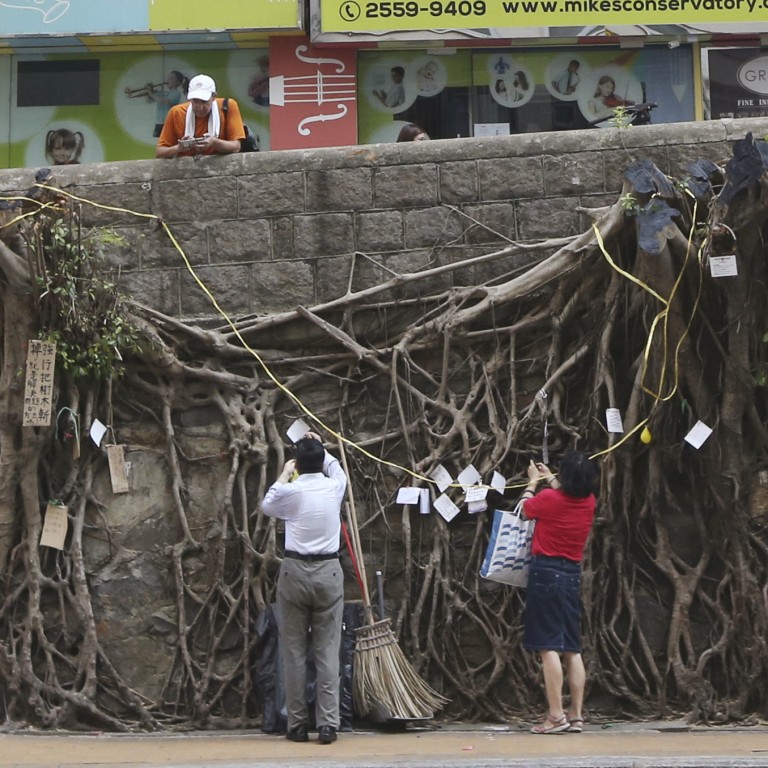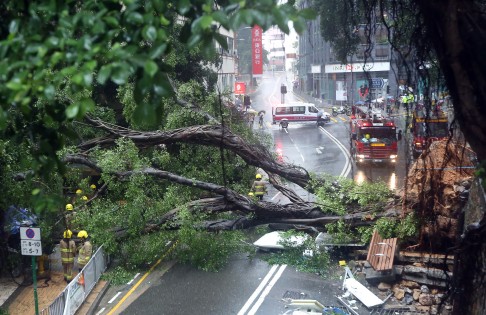
It's a saw point: why Hong Kong's urban trees need managing better
Shortage of trained arborists, faulty procedures, and low status of tree care as a job blamed for crude hacking of trees and removal of some from city's walls
Don Picker still finds it upsetting to visit the Bonham Road area in Mid-Levels. It's hard for the veteran arborist to see stumps where once there were four magnificent Chinese banyans growing out of the stone embankment on St Stephen's Lane - the result, as he sees it, of needless tree-felling.
The Highways Department action was prompted by the earlier collapse of another tree in the area during a severe storm, injuring two people. Consultants found a second tree in the vicinity to be in poor condition and it was duly removed. But two weeks later, on the evening of August 7, Highways officials decided to cut down the remaining banyans, saying that new cracks discovered in the stone wall made the trees unstable and prone to collapse.
Workers moved in quickly, and by the next morning the quartet of century-old banyans had been removed.

Picker, managing director of the Asia Tree Preservation company, says he had looked at the trees earlier and noticed that they had already been trimmed to reduce the weight of the crowns. He laments the felling, saying that the ancient banyans could have been saved with some structural reinforcement.
Hong Kong is one of the few cities in the world with a large number of so-called stone-wall trees. These are - known variously as Chinese banyan, Indian laurel and curtain fig - a hardy species that can thrive on walls and other concrete structures as their roots burrow through cracks.
Singapore had a few but most were removed. In contrast, Hong Kong Island has a proliferation of trees that sprang up on walls and slopes over the past century, and residents increasingly value the softening effect of the greenery amid the city's sprawl of high-rises.
Several arborists, including Picker and Ken So Kwok-yin, have proposed solutions for preserving the city's stone-wall trees. Arguing that the banyans should be viewed together with walls as a single entity, the experts had called for structural engineers to be consulted along with tree experts.
Many residents mourned the loss of the aged banyans on Bonham Road, expressing their feelings by posting notes and tying balloons on the roots. However, the tree felling was conducted with backing from the Tree Management Office (TMO), which agreed that the action was in the interests of public safety.
The office, which monitors 1.7 million trees in urban areas, was created five years ago following an inquest into the death of a university student from injuries caused by a falling tree.

The tragedy occurred in August 2008 on Stanley Main Street, days after severe tropical storm Nuri hit the city. Although government workers had made an inspection not long before the accident and deemed the century-old coral tree to be healthy, subsequent examination showed that it had been severely weakened by fungus infection.
Concluding that both city administrators and frontline workers lacked professional knowledge in tree management, the Coroner's Court recommended that an independent body be created to conduct regular risk assessment of trees and help train more professionals, hence the Tree Management Office.
The office subcontracts out most of its tree appraisals, which are conducted at intervals of between six months and a year.
And with about 1.7 million trees in urban areas under its supervision, there's plenty to keep the fewer than 1,000 certified arborists in Hong Kong busy.
However, Picker says the accuracy of their assessments of trees' health can vary considerably, not only because of the arborist's experience, but because the reporting format is too subjective.
Holding up a copy of a tree assessment form in his Fo Tan office, Picker points out that the review is based mainly on visual inspection: there are yes/no boxes for categories such as "asymmetric tree canopy" or "heavy crown load", while conditions such as decay, fungus infection and insect disease are rated from one to 10.
A risk rating is then calculated based on these numbers.
These are not sufficient to give a clear picture of a tree's health, Picker says, noting that there is no provision for detailed comments and photographs to accompany the reports.
Instead, he calls on the government to adopt the basic form used by the International Society of Arboriculture (ISA), which requires inspectors to look for more specific indicators, take measurements and which allows for description of the tree's state as well as diagrams to illustrate the site.
The ISA format would lead to more accurate evaluations of tree condition and, in turn, help the office look after its trees more effectively, Picker says.

Deborah Kuh Wen-gee, head of the Tree Management Office since May, argues that theirs is a work in progress. "It's an evolutionary process like any other city. Other post-industrial cities started late too, like Australia where I grew up," she says.
Kuh concedes there will be inconsistencies in how trees are assessed because the field is so new, but encourages arborists to take continuing education courses to help "build the arc to maturity".
Hong Kong's first generation of arborists were certified in 2006, and professionals like Picker welcome the government effort to establish standards in a field that emerged in Hong Kong just a dozen years ago.
In particular, more needs to be done to properly train tree workers. Frontline tree care is still considered unskilled labour, and that is the view that needs to change, says the president of the International Society of Arboriculture Hong Kong, John Ho Kin-chuen.

For instance, he says, there are only about 60 ISA-qualified tree climbers in the city.
"Arborists mostly do inspection and assessment, but we need people who know how to use equipment and make the proper cuts to do the actual operation.
"It is the trained climbers and cutters who can correctly remove branches that have decayed or are at risk of breaking. They also know where to trim to control a tree's growth, or reduce the crown weight, helping maintain "good tree form", Ho says.
With a young tree, this means using special pruning techniques and removing weakened tree branches. In older trees, the branches are larger and so more considerations need to be made.
However, many unskilled tree workers cut branches without much thought, Ho says. As a result, more than 90 per cent of tree cutting work is unsatisfactory, and may be damaging instead.

"When the wrong cuts are made, especially on larger branches, it is difficult for the tree to recover, and [the work] may need to be redone six to nine months later."
Hong Kong's professional tree workers are being trained by Ken So. One of Hong Kong's first certified arborists, he now runs the tree management and conservation diploma course at HKU Space.
The programme teaches students about tree biology, tree care, pruning, and urban forest management. Students also conduct tree identification and some climbing on field trips, although opportunities for practical training are sporadic. Even so, each intake attracts up to 40 people, whose ages range from twentysomething to 60.
So, who has been searching for a suitable site where his trainees can conduct field exercises, says while there is no shortage of managers in tree care, Hong Kong needs considerably more professional frontline workers.
Arborists mostly do inspection and assessment, but we need people who know how to use equipment and make the proper cuts to do the actual operation
With just 20 staff on her team at the TMO, Kuh appreciates private-sector arborists' push for improved tree assessment and professional training. However, resolving those needs will not overcome issues related to the city's stone-wall trees.
Although the aged banyans on Bonham Road may have been removed in haste, Kuh says it was an emergency situation.
"The timing was unfortunate … but it was an emergency removal and we stand by it," she says firmly. "[Highways Department workers] noticed there were cracks in the wall and when the structural stability becomes an unknown, it's more susceptible to climatic variations. And there was an impending thunderstorm … there was just no way. The roots were interlocked. They could have fallen at once, together. Is that a risk you would take? Maybe the public will have a lower risk threshold, but the government doesn't have that luxury. For us, public safety does come first."

Stone-wall trees are accidents of nature - seeds carried by wind or animals become lodged in a crevice, germinate and perhaps thrive for decades, or even centuries. No one would deliberately plant trees on stone walls but the government needs to manage such existing trees, Kuh says.
"There is a beauty and beast element. [The trees] are beautiful, but there is also a very dangerous element to them. There are tree experts who would look at them as a pure hazard and just remove them.
"If you look at it from another perspective, they were left to grow the way they are; we would never design it like that.
"It's part of the charm and there's a danger so we need to come up with a happy marriage."

